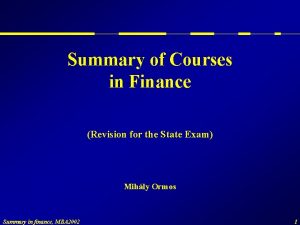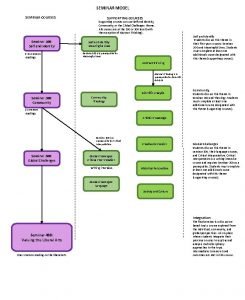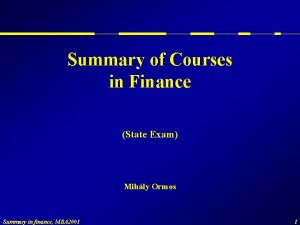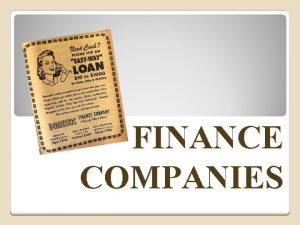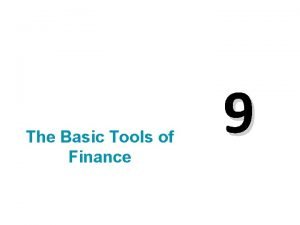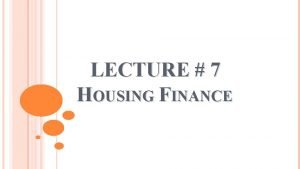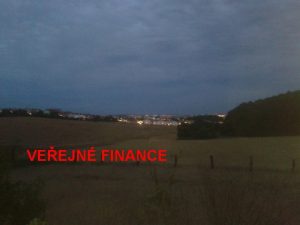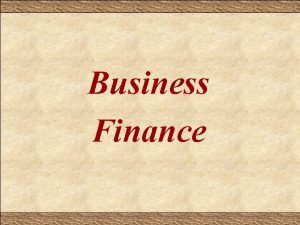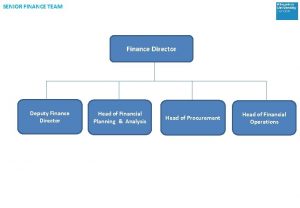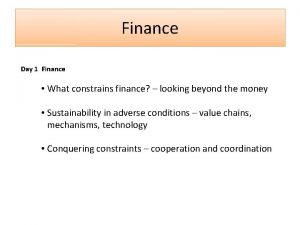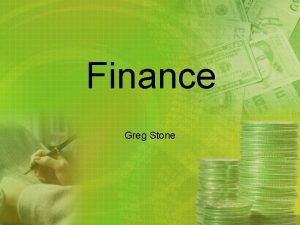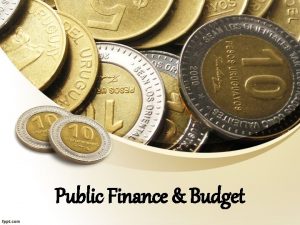Summary of Courses in Finance Revision for the






















































- Slides: 54

Summary of Courses in Finance (Revision for the State Exam) Mihály Ormos Summary in finance, MBA 2001 1

Business Economics & Corporate Finance 9. Financing corporations – Pure equity financed mini-firm approach – Effects of capital structure in a perfect market – Effects of capital structure in a slightly imperfect market 10. Dividend policy – Significance of indifference of dividend policy in financial analyses – Explaining the indifference of dividend policy in a perfect market – Explaining the indifference of dividend policy in a slightly imperfect market Summary in finance, MBA 2001 2

Business Economics & Corporate Finance 11. Determination of cash flow streams – Relevant cash flows – Consideration of inflation – Consideration of taxation 12. Determination of opportunity cost – Determination of opportunity cost by the CAPM – Country risk approach – Opportunity cost by WACC 13. Business economic analyses – Net present value – Internal rate of return – Profit index and annual equivalent Summary in finance, MBA 2001 3

Business Economics & Corporate Finance 14. Options – Properties of options – Factors influence put and call option prices – Real-options 15. Companies in the modern market economies – Main types of modern market economies – Shareholder’s value – stake holder’s approach – Mechanism of shareholder’s value Summary in finance, MBA 2001 4

Financing Pure equity financed mini-firm approach Firm Shareholder Project Investment decision βproject IRR Dividend Capital Tőkepiaci m. alternative alternatíva Summary in finance, MBA 2001 ralt 5

Financing Pure equity financed mini-firm approach If perfect capital market is assumed, the influence of debt policy on the value (Net Present Value) is negligible, therefore in economic analyses of projects pure equity financed mini-firm will be assumed. Summary in finance, MBA 2001 6

Financing Effects of capital structure in perfect market Nine different factors should be investigated: – Value, Expected return and Risk of the – Firm, Equity, Debt The Firm The value of the firm is equal to the sum of the value of equity and the value of debt V=E+D (the capital structure can be characterised as the financial leverage of the firm which is shown by the D/E ratio) The expected return of the firm [E(r. V)] and the risk of the firm [βV] are given by the projects of the firm Therefore the value, the expected return and the risk of the firm is independent from the capital structure of the company, so from the D/E ratio Summary in finance, MBA 2001 7

Financing Effects of capital structure in perfect market Debts The risk of the debts (βD) in a low leveraged situation is 0, because the equity covers the debts, therefore the required return of the debts (r. D) is equal to the risk free return. After a certain leverage the risk and therefore the required return of the debts begin to increase, because the probability of debt trapping is increased. Summary in finance, MBA 2001 8

Financing E(r) in perfect market E(r. V) r. D rf 0 Risk-free Debt Risky Debt 1 D/E r. M β βV βD 0 Risk-free Debt Summary in finance, MBA 2001 Risky Debt 1 D/E 9

Financing Effects of capital structure in perfect market Equity Rearranging the previous two equations (Firm) to the expected return and to the risk of the equity the next relations can be found: Summary in finance, MBA 2001 10

E(r) E(r. E) E(r. V) Financing in perfect market r. D rf 0 Risk-free debt Risky debt 1 β D/E βE βV βD 0 Risk-free debt Risky debt Summary in finance, MBA 2001 1 D/E 11

Financing Effects of capital structure in perfect market Equity (Stocks) The leverage increases the risk (βE) and the expected return (E(r. E)) of the stocks, however, the value of the stocks is not affected (the risk and the expected return is increasing together in the function of D/E, so it is just sliding up on the security market line of the CAPM), therefore the capital structure is indifferent for the shareholders. Summary in finance, MBA 2001 12

Financing E(r) in perfect market E(r. E) E(r. V) r. D rf 0 Risk-free debt Risky debt 1 β D/E βE βV βD 0 Risk-free debt Risky debt Summary in finance, MBA 2001 1 E(r) V E(r. V) rf E D βV β D/E 13

Financing Effects of capital structure in perfect market Conclusion The changing D/E ratio has no effect on the value of the firm, the equity and the debt (MM. I. ) The expected return of the equity is proportionally increasing with the D/E ratio. The rate of increase in the beginning is linear, then due to the increasing required rate of debt return (r. D) the increase slows down. (MM. II. ) This is why the pure equity financed “mini-firm” approach is adequate in corporate financial analyses. Summary in finance, MBA 2001 14

Financing Effects of capital structure in a slightly imperfect market I. Corporate tax (*) Financing the corporation by debts is advantageous, because interest connected to the debts can be cleared in the books as financial expenditure so the tax base is reduced and with this the tax liability is decreased. (annual tax saving= tc • D • r. D) The tax saving means cost reduction, so raises the expected cash flow and return of the firm. It can be derived that the present value of a leveraged firm is increased by ~tc. D. This increase is due to the shareholders. Summary in finance, MBA 2001 15

E(r) E(r. E)* E(r. E) E(r. V)* r. D(1 -tc) E(r. V) rf E(r) E(r. V) rf 0 Risk-free debt Risky debt 1 V* V D/E D D βE β βV P β E E* V* V E βV E* βD 0 Risk-free debt Risky debt Summary in finance, MBA 2001 1 D D/E 0 1 D/E 16

Financing Effects of capital structure in a slightly imperfect market I. Corporate tax (*) II. Personal income tax as well (**) All elements of the capital structure are taxed with almost the same rate, therefore it is indifferent in capital structure decisions. III. Financial distresses (***) Financial distress occurs when the company is not able to cover its liabilities due to the high financial leverage and in this case the legal regulation over-defenses the state and the debtors and over-weakens the position of the shareholders. The probability of this kind of situation is increased by the D/E ratio, so decreasing the value of the stocks. Summary in finance, MBA 2001 17

Financing Effects of capital structure in a slightly imperfect market P V** V V*** Value losses due to Financial distresses E*** 0 D/Eopt D/E Even in case of slight market imperfection, the value changing effect of the financial leverage is negligible, so the pure equity financed mini-firm approach is appropriate. Summary in finance, MBA 2001 18

Dividend policy Significance of indifference of dividend policy in financial analyses If the indifference of dividend policy is assumed, then the project Firm analyses can. Project be derived through the cash flow steams of a pure equity financed mini-firm, so the shareholder’s cash flows resulted from dividend pay Investment β IRR Shareholder offs can be neglected. decision If above hypothesis can be proved, the corporate financial analyses are highly simplified, because the Dividend mini-firm approach can be used. project Capital Tőkepiaci m. alternative alternatíva Summary in finance, MBA 2001 ralt 19

Dividend policy Explaining the indifference of dividend policy in a perfect market The suppositions (circumstances) the firm has settled on its investment program (i. e. it is already worked out that how much of this program can be financed by borrowing, and the plan meets other funds requirements) perfect market (fair issuing price, zero transaction cost, equal tax rates – dividend and price earnings) What happens if the dividend wanted to be increased without changing the investment and borrowing policy? The only solution is to print some new shares and sell them. Miller and Modigliani states that the dividend policy has no affect to the value of the firm in the above circumstances. Investment and borrowing policy is determined so to increase the value of dividend new shares have to be offered so one part of the company become the property of the new owners. Summary in finance, MBA 2001 20

Dividend policy Explaining the indifference of dividend policy in a perfect market Before dividend After dividend Total value of firm New stocks money price decrease It is indifferent for the old owners how they get money by dividend or by selling some of their stocks. Summary in finance, MBA 2001 21

Dividend policy Explaining the indifference of dividend policy in a perfect market Shares Dividend financed by stock issue No dividend no stock issue New stockholders Cash Firm Shares Cash Old stockholders Summary in finance, MBA 2001 Old stockholders 22

Dividend policy Explaining the indifference of dividend policy in a slightly imperfect market Arguments usually presents some kind of market imperfection (tax differences, transaction cost) Reasons to pay higher dividend – There is a conservative group which believes that an increase in dividend payout increases firm value – In lack of information the high dividend is a good sign – The paid dividend is certain while the price increase is uncertain Reasons to pay lower dividend – High transaction cost of issuing – Higher taxation of divined incomes Summary in finance, MBA 2001 23

Dividend policy Explaining the indifference of dividend policy in a slightly imperfect market Even in case of slight market imperfections the indifference can be defended. Empirically it can be proven that a supply-demand equilibrium is created between investors’ preferences to dividend and corporations’ dividend policies. If there existed better dividend policy, all company would use this, however many kind of policies can be found in the market. Summary in finance, MBA 2001 24

Determination of cash flow streams Introduction What is the aim of determination of cash flows? – Corporate financial analyses are based on the future cash flows created by the project. – These cash flows will be examined through the analyses Summary in finance, MBA 2001 25

Determination of cash flow streams • • Relevant cash flows Cash flows should be estimated on change base All derivative effects have to be considered (with or without) Opportunity cost has to be taken into consideration Sunk Cost Careful separation of overheads Working capital needs Sub-versions should be separated Financing effects should be considered separately Summary in finance, MBA 2001 26

Determination of cash flow streams Consideration of inflation Using nominal values. All cash flows are considered on current price, so the estimated price changes tendencies – of e. g. material costs, payments to personnel, selling price – are calculated. Of course the opportunity cost should be considered in the same way. Using real values. Unchanging, today prices are considered, but in this case the opportunity cost should be estimated on the same way. Summary in finance, MBA 2001 27

Determination of cash flow streams Consideration of taxation Most taxes are taken into account as costs, i. e. they are considered as indirect or general expenditures for which the base is the net profit. General rule that is in the estimation of cash flows and in the estimation of opportunity cost the same calculation procedure should be used. Summary in finance, MBA 2001 28

Determination of opportunity cost by the CAPM The opportunity cost gives the reference return in economic analyses. The project’s expected return have to exceed this to be worthy for the owner to accomplish the investment. In the determination of the opportunity cost we have to start from the CAPM. – There exists risk-free asset – There is a premium accompanied to risk taking – The required, expected and average returns are equal Summary in finance, MBA 2001 29

rf Determination of opportunity cost by the CAPM By definition the return of the risk free asset (time premium) is the return of any real asset with zero standard deviation. (There is no asset like this…) In the estimation the return of that financial asset should be considered, which certainly pays back the claim with its interest. There is only one issuer which can guarantee that this will happen and this is the government. Therefore some kind of government security should be considered. The risk of inflation can be eliminated in two ways: – inflation indexed government security – modifying with the estimated inflation rate If the return of government security is changing in time, the return of zero-coupon bonds, or the return of security with similar maturity to the project life time. Summary in finance, MBA 2001 30

r. M Determination of opportunity cost by the CAPM By definition the return of the market portfolio can be given by the expected return of that portfolio which represents the capitalization weighted average return of all securities traded in the world. This can be approximated with the global portfolios e. g. MSCI world index However it would be rational to hold the global portfolio (MSCI), however there are many factors against the rational behaviour. Therefore a segmentation of the global market can be discovered. In this case separate CAPM worlds can be found. and the return of the market portfolios of these worlds depends on the expectations of the investors in the given world. Summary in finance, MBA 2001 31

Determination of opportunity cost by the CAPM We are always interested in the opportunity cost of projects, (but the risk of a specific project and the risk of a specific stock (company) is not necessarily equal) nevertheless capital market information is available only on stocks. Two step procedure – Estimation of unlevered betas – From unlevered calculation of project betas Main factors cause the differences: – Sales revenues sensitivity to fluctuation of the whole economy – Effect of operating leverage Fix Cost / Total Cost – Financial leverage MM II. For starting point we can choose the beta of the given company if the function of the project is similar to the function of the firm, otherwise industrial averages can be used. Summary in finance, MBA 2001 32

Determination of opportunity cost Country risk approach This approach can be used in those countries which has a fairly young capital market. In this case developed capital market data can be used as the basis of the estimation. The above data should be modified by the country risk factors which can be defined by the characteristics of the capital markets and other factors. This modification is a three step procedure: 1. Determination of the country risk factor which can be found by the creditratings of financial consulting companies like the moody’s or blomberg. 2. From this rating the extra return connected to government securities can be found so this has to be converted to the extra premium of stocks i. e. companies. 3. Determination of the relationship between the firm and the country concerning the risk. Summary in finance, MBA 2001 33

Determination of opportunity cost Opportunity cost by WACC The expected return of the firm can be expressed as the weighted average of the expected return on equity and debt, this is called the Weighted Average Cost of Capital: WACC is used in opportunity cost estimation in case of the investigated project’s business activity (risk) is close to the business activity (risk) of the firm. The idea behind the calculation shows that the project should create a profit at least which covers above the interest on debt the required return of equity. If the corporate income tax is considered as well then the above expression is modified to Summary in finance, MBA 2001 34

Business economic analyses Introduction The main steps of a corporate financial analyses are – Determination of opportunity costs (identification of the return of alternative capital market investment possibility with similar risk) – Determination of future cash-flows (this is the sum of economic effects of the project) – Economic analyses (comparison between the profitability of the project and the alternative investment possibility) • NPV, IRR, PI, AE Summary in finance, MBA 2001 35

Business economic analyses Net present value Net Present Value is the sum of discounted cash-flows of a given project by the opportunity cost. So in this way the economic value of a project can be compared to other investment possibility with the same risk. The result of NPV calculation shows the value increase above the alternative investment possibility. Therefore, the project will be implemented if the NPV>0. Summary in finance, MBA 2001 36

Business economic analyses Internal rate of return Internal Rate of Return is defined as the rate of discount which makes the NPV=0. In this case the average return of the project is determined and this is compared to the opportunity cost. So the IRR rule is to accept an investment project if the opportunity cost of capital is less then the IRR. Pitfalls of IRR: – It shows the average return of the project i. e. the increase of unit equity in unit time – Lending or borrowing – Multiple rates of return – Mutually exclusive projects – Short- and long term interest rates may differ Summary in finance, MBA 2001 37

Business economic analyses Profit Index and Annual Equivalent Profit index is the quotient of the Net Present Value and the investment cost of the project: It is used in case of limited capital, for mutually exclusive projects. Summary in finance, MBA 2001 38

Business economic analyses Profit Index and Annual Equivalent Annual equivalent can be used to compare mutually exclusive and repeating projects with different life time. In this case the future cash-flows of the project converted to annuity and these annuities will be compared (NPV of the normal cash flows has to give the same result as the NPV of the annuity) Summary in finance, MBA 2001 39

Companies in the modern market economy Introduction Development of public limited corporations Early capitalism • • individuals and families unlimited liability the owner and the manager is the same Development of technology and mass production required the concentration of capital Limited liability • legal entity • shares are tradable More owner one company • management and ownership are separated, but • the goals are different • agency problem Summary in finance, MBA 2001 40

Companies in the modern market economies Main types of modern market economies The types are connected to the degree, the manner, and the function of intervention of the state into the economic processes. The three form of modern market economy: – Corporate (market) controlled (Anglo-Saxon) – State controlled (Asian capitalism) – Negotiation based market economy (Rhenish) Summary in finance, MBA 2001 41

Companies in the modern market economies Main types of modern market economies Corporate (market) controlled (Anglo-Saxon) The role of the state is narrow USA, Great-Britain – Weak feudalism – Parliamentary political system – Smooth and continuous industrialisation Summary in finance, MBA 2001 42

Companies in the modern market economies Main types of modern market economies State controlled Relatively the highest state coordination – intervenes the microeconomic processes – selectively influences the operations of companies – plays a significant role in the allocation of recourses like • state owned firms • financing R&D • reduced rate credits Japan and France – Strong feudalism and aristocracy – Late but rapid industrialisation, therefore – High industrial concentration – The bank system has a significant role – The state in sight of the international competition strengthened its position. Summary in finance, MBA 2001 43

Companies in the modern market economies Main types of modern market economies Negotiation based market economy The economic processes are based on the negotiations of the leading economic roles. The main idea is “social partnership” i. e. political consensus between the employers, the employees, and the bureaucracy. The negotiations include: – wages – prices – taxes – employment – economic stability and growth Summary in finance, MBA 2001 44

Companies in the modern market economies Main types of modern market economies by the financing system of the economy By the role of the bank system three types can be distinguished: Capital market based financing system – New recourses can be obtained by issuing stocks or bonds, bank loans are used mainly for temporary financing Credit based financing system with administrative dominance – Small and moderate exchanges so the firms have to use the banks for financing. – Subsidies through the banking system Credit based financing system with institutional dominance – Some large banks, and they have shares in the firms, investment funds are owned Summary in finance, MBA 2001 45

Companies in the modern market economies Shareholder’s value – stake holder’s approach Share holder’s value approach: – Only the growth of the company’s value counts – The firm works as a “revenue producing machine” – From the 90’s this form became the major approach – Capital market based financing system Stake holder’s value – They are the buyers, the suppliers, the investors, the creditors, the employees, the government – Their interests should be considered – More comfortable, and humane – Credit based financing system Summary in finance, MBA 2001 46

Companies in the modern market economies Mechanism of shareholder’s value If there are dominant shareholders’ of the company, the board of directors and carrier competition work well. If the ownership is crumbled (because of the demand of capital new issues happened, diversification of owners, etc. ) then the intervention of owners to the business activity of the firm is decreased even the members of the board could be delegated by the management. However, if the shareholders’ is pushed into the background, then the firm is usually pushed to the edge, so the owners are gladly sell their stocks and by this the buyout of the company can happen, and the new owners are easily fire the management. Summary in finance, MBA 2001 47

Derivatives Properties of options Derivative instruments are financial assets with returns depend on value of other factors. Two basic types: – Termins (forwards and futures) Termin transactions are basically sales contracts for a predefined future date, however the seller does not have to own the asset of the contract. – Options give the opportunity to buy or sell an asset on a specified price. Summary in finance, MBA 2001 48

Derivatives Properties of options Types of option: – Call is the opportunity or obligation to buy – Put is the opportunity or obligation to sell – Short positions are obligations to sell or buy (writer) – Long positions are rights to sell or buy Option price or premium is the value which have to be paid by the buyer for the opportunity. Exercise of Strike price is the predefined (contracted) price of the asset (K). X 0 is the actual price of the asset The owner of an option can – sell the option on actual price – at expiration draw the option – wait until expiration and do nothing American vs. European option Summary in finance, MBA 2001 49

Value of Call and Put options at expiration LC LP K K K X SC K X SP K K X K Summary in finance, MBA 2001 X K 50

Profit on Call and Put options Profit on LP Profit on LC K K K FV(c) K X Profit on SC X FV(p) Profit on SP FV(c) FV(p) K X K K Summary in finance, MBA 2001 51

Derivatives Factors influence option prices • Actual stock price • Strike or Exercise price • Intrinsic value (relation of X 0 and K) – Call ITM situation the intrinsic value = X 0 -K – Call ATM and OTM situation this value is 0 • Volatility of the stock returns (standard deviation of annual returns) • Time to option expiration • Mature dividend until expiration • Risk free return (i. e. the present value of exercise price) • Time value of option The difference between the value of the option (c) and its intrinsic value Summary in finance, MBA 2001 52

Derivatives Factors influence option prices Value of LC Actual price: X 0 Modified intrinsic value: X 0 -PV(K) Value of option: c K-PV(K) PV(D) Intrinsic value: X 0 -K PV(K)+PV(D) X 0 K X 0 -PV(K)-PV(D) PV(K)+PV(D) Summary in finance, MBA 2001 53

Derivatives Real-options Real options are option analogies fitted to corporate investments by which those parameters can be evaluated that cannot be included in NPV calculations. Like derivative investment possibilities (Call option) possibility of leaving a business (Put option) Summary in finance, MBA 2001 54
 Revision passive
Revision passive Fspos vägledning för kontinuitetshantering
Fspos vägledning för kontinuitetshantering Novell typiska drag
Novell typiska drag Nationell inriktning för artificiell intelligens
Nationell inriktning för artificiell intelligens Ekologiskt fotavtryck
Ekologiskt fotavtryck Varför kallas perioden 1918-1939 för mellankrigstiden?
Varför kallas perioden 1918-1939 för mellankrigstiden? En lathund för arbete med kontinuitetshantering
En lathund för arbete med kontinuitetshantering Personalliggare bygg undantag
Personalliggare bygg undantag Tidbok för yrkesförare
Tidbok för yrkesförare Sura för anatom
Sura för anatom Densitet vatten
Densitet vatten Datorkunskap för nybörjare
Datorkunskap för nybörjare Tack för att ni lyssnade bild
Tack för att ni lyssnade bild Debattartikel mall
Debattartikel mall Delegerande ledarstil
Delegerande ledarstil Nyckelkompetenser för livslångt lärande
Nyckelkompetenser för livslångt lärande Påbyggnader för flakfordon
Påbyggnader för flakfordon Tryck formel
Tryck formel Publik sektor
Publik sektor Kyssande vind analys
Kyssande vind analys Presentera för publik crossboss
Presentera för publik crossboss Argument för teckenspråk som minoritetsspråk
Argument för teckenspråk som minoritetsspråk Vem räknas som jude
Vem räknas som jude Klassificeringsstruktur för kommunala verksamheter
Klassificeringsstruktur för kommunala verksamheter Fimbrietratt
Fimbrietratt Bästa kameran för astrofoto
Bästa kameran för astrofoto Centrum för kunskap och säkerhet
Centrum för kunskap och säkerhet Verifikationsplan
Verifikationsplan Mat för unga idrottare
Mat för unga idrottare Verktyg för automatisering av utbetalningar
Verktyg för automatisering av utbetalningar Rutin för avvikelsehantering
Rutin för avvikelsehantering Smärtskolan kunskap för livet
Smärtskolan kunskap för livet Ministerstyre för och nackdelar
Ministerstyre för och nackdelar Tack för att ni har lyssnat
Tack för att ni har lyssnat Referatmarkeringar
Referatmarkeringar Redogör för vad psykologi är
Redogör för vad psykologi är Borstål, egenskaper
Borstål, egenskaper Atmosfr
Atmosfr Borra hål för knoppar
Borra hål för knoppar Orubbliga rättigheter
Orubbliga rättigheter Stickprovsvariansen
Stickprovsvariansen Tack för att ni har lyssnat
Tack för att ni har lyssnat Rita perspektiv
Rita perspektiv Verksamhetsanalys exempel
Verksamhetsanalys exempel Tobinskatten för och nackdelar
Tobinskatten för och nackdelar Toppslätskivling effekt
Toppslätskivling effekt Datumr
Datumr Egg för emanuel
Egg för emanuel Elektronik för barn
Elektronik för barn Vad kallas den mantel som bars av kvinnor i antikens rom
Vad kallas den mantel som bars av kvinnor i antikens rom Strategi för svensk viltförvaltning
Strategi för svensk viltförvaltning Kung dog 1611
Kung dog 1611 Humanitr
Humanitr Ro i rom pax
Ro i rom pax Tack för att ni lyssnade
Tack för att ni lyssnade
























































